
Robert Schumann was a German composer, pianist, and influential music critic. He is widely regarded as one of the greatest composers of the Romantic era. Schumann left the study of law, intending to pursue a career as a virtuoso pianist. His teacher, Friedrich Wieck, a German pianist, had assured him that he could become the finest pianist in Europe, but a hand injury ended this dream. Schumann then focused his musical energies on composing.

The Piano Concerto in A minor, Op. 54, by the German Romantic composer Robert Schumann was completed in 1845 and is the composer's only piano concerto. The complete work was premiered in Dresden on December 4 of 1845. It is one of the most widely performed and recorded piano concertos from the Romantic period.

The family Stylidiaceae is a taxon of dicotyledonous flowering plants. It consists of five genera with over 240 species, most of which are endemic to Australia and New Zealand. Members of Stylidiaceae are typically grass-like herbs or small shrubs and can be perennials or annuals. Most species are free standing or self-supporting, though a few can be climbing or scrambling.

Donatia is a genus of two cushion plant species in the family Stylidiaceae. The name commemorates Vitaliano Donati, an Italian botanist.

Stylidium section Tenella is a taxonomic rank in the plant kingdom under Stylidium subgenus Andersonia. In 2000, A.R. Bean published a taxonomic revision of subgenus Andersonia and established this section to separate these eleven species based on morphological and cladistic analysis. This taxonomic rank is named after George Bentham's series Tenellae, which he established in his 1869 treatment of the family Stylidiaceae. Series Tenellae was not used in Johannes Mildbraed's 1908 taxonomic monograph in which he completely revised the subgeneric taxonomy of the genus. Mildbraed's treatment of the genus taxonomy is the general demarcation which has been used in subsequent revisions and additions.
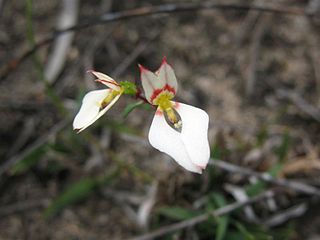
Levenhookia, also known as the styleworts, is a genus of ten recognized species in the family Stylidiaceae and is endemic to Australia. The genus is restricted to Western Australia almost exclusively with a few exceptions: L. pusilla's range extends into South Australia, L. dubia's range extends through South Australia into Victoria and New South Wales, L. sonderi is native only to Victoria, and L. chippendalei is also found in the Northern Territory.
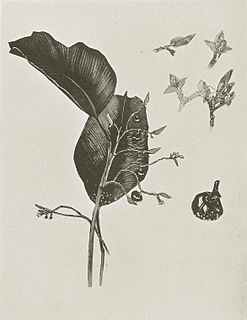
Sarcophrynium is a genus of plant in family Marantaceae indigenous to tropical Africa. It was described as a genus in 1902.
Scaphopetalum is a genus previously classified under the plant family Sterculiaceae. Currently, under the APG IV system the genus is placed under the subfamily Byttnerioideae of the family Malvaceae senso lato. The distribution of the genus is restricted to the rain forests of Africa. In total 26 taxa have been described, 21 have been recognized, two invalid and one nomen nudus.
Levenhookia sonderi, the slender stylewort, is a dicotyledonous plant that belongs to the genus Levenhookia. It is an ephemeral annual that grows only in Victoria, Australia. L. sonderi is most closely related to L. dubia and it has even been described as a variety of L. dubia in the past. Johannes Mildbraed was the first person to reduce L. sonderi to a variety of L. dubia in his 1908 taxonomic monograph on the Stylidiaceae in which he noted he could not find any significant difference between L. sonderi and L. dubia to maintain the separate taxonomic treatment of the two species. Later studies have considered the species to be distinct.

Levenhookia stipitata, the common stylewort, is a dicotyledonous plant that belongs to the genus Levenhookia. It is an ephemeral annual that grows about 7–10 centimetres (2.8–3.9 in) tall with oblanceolate to linear leaves. Flowers are pink and bloom from August to January in its native range. L. stipitata is endemic to southwestern Western Australia where it grows in granitic or lateritic soils. This species was first described by George Bentham in 1837 as Stylidium stipitatum and was later reclassified into the genus Coleostylis, which was placed into synonymy with the genus Levenhookia.

Levenhookia sect. Coleostylis is a section of four recognized species in the family Stylidiaceae. It was established and described by Johannes Mildbraed in 1908 to separate the subgeneric taxonomy in the genus Levenhookia. Mildbraed originally placed L. preissii and L. stipitata in this section. L. chippendalei was described in 1966 and placed in this section by Rica Erickson and Jim Willis. Section Coleostylis could also contain L. octomaculata, which Erickson described in 1956, noting its affinities with L. stipitata but without placing it in a section. Otherwise it would be unplaced as to a section.
Levenhookia sect. Estipitatae is a section of two to three recognized species in the family Stylidiaceae. It was established and described by Johannes Mildbraed in 1908 to separate the subgeneric taxonomy in the genus Levenhookia. Mildbraed originally placed L. dubia and L. leptantha in this section. L. sonderi was described by Mildbraed as a variety of L. dubia, though other resources treat it as a distinct species.

Levenhookia sect. Levenhookia is a section of two to three recognized species in the family Stylidiaceae. Section Levenhookia was originally described by Mildbraed as section Eulevenhookia, which was later changed to the current section title Levenhookia as an autonym since it is the type section. Mildbraed originally placed L. pauciflora and L. pusilla in this section. It could also contain L. pulcherrima, which Carlquist described in 1969 and noted its close association to the other two species in section Levenhookia but neglected to place it within a section.
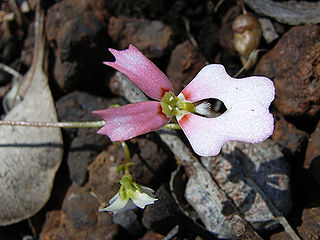
Stylidium calcaratum, the book triggerplant, is a dicotyledonous plant that belongs to the genus Stylidium. It is an ephemeral annual that grows from 5 to 10 cm tall but can grow larger at 20–30 cm tall in damp forest or scrub habitat. The few ovate leaves produced by this plant form basal rosettes around the stem. The leaves are around 3–5 mm long on short petioles. The scapes are 2–30 cm tall and produce single flowers in smaller plants and up to nine flowers in larger, more robust plants. Flowers are pink or white with red spots or lines at the individual petal bases. The petals are vertically paired and will fold over to meet each other at night or in adverse weather conditions. S. calcaratum is endemic to Australia and has a distribution that ranges from Victoria through South Australia and into Western Australia. Its habitat is recorded as being wet flats or near creeks and seepages. Pollination is achieved by a grey fly, Comptosia cuneata.

Stylidium perpusillum, the tiny triggerplant, is a dicotyledonous plant that belongs to the genus Stylidium, that occurs in south west Western Australia.
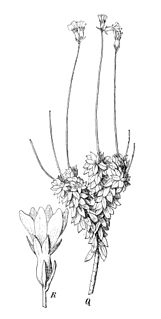
Forstera is a genus of small perennial plants in the Stylidiaceae family named in honour of the German naturalists Johann Reinhold Forster and his son, Georg Forster, who had previously described Forstera's sister genus, Phyllachne just five years earlier. It comprises five species that are endemic to New Zealand with the exception of F. bellidifolia, which is endemic to Tasmania. The species in this genus resemble those in a subgenus of the related genus Stylidium called Forsteropsis, but they are more closely related to the genus Phyllachne. Proposals to merge the two genera based on information from cladistic analysis have emerged because of these genera's morphological similarities and evidence that they are paraphyletic.

Parodia leninghausii is a species of South American cactus commonly found as a houseplant. Common names include Lemon Ball cactus, Golden Ball cactus and Yellow Tower cactus.
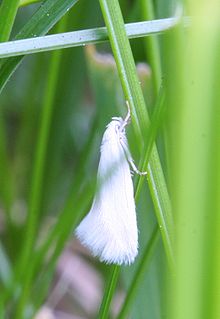
Elachista is a genus of gelechioid moths described by Georg Friedrich Treitschke in 1833. It is the type genus of the grass-miner moth family (Elachistidae). This family is sometimes circumscribed very loosely, including for example the Agonoxenidae and Ethmiidae which seem to be quite distinct among the Gelechioidea, as well as other lineages which are widely held to be closer to Oecophora than to Elachista and are thus placed in the concealer moth family Oecophoridae here.
Duboscia is a small plant genus, with two species, in the family Malvaceae. The genus occurs from the Ivory Coast to the Democratic Republic of Congo. The genus was previously in the Tiliaceae, under the APG classification it is now placed in the Malvaceae.
The Gewandhaus Quartet is a string quartet based in Leipzig. It was founded in 1808 by members of the Gewandhaus Orchester, as one of the first professional quartets in the world. In its more than 200-year history, they played many world premieres.













